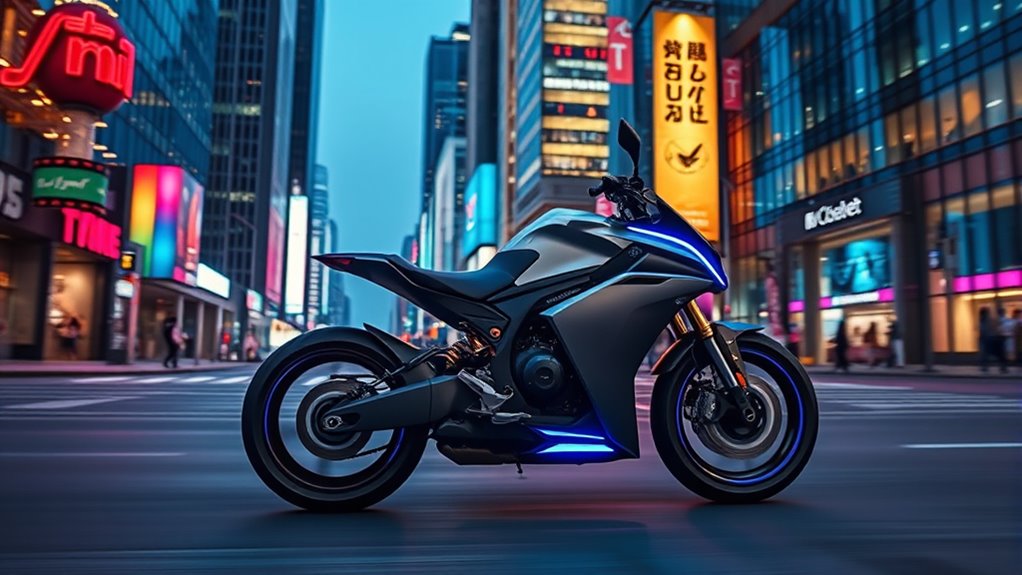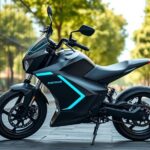The future of electric motorbikes will see faster charging, longer ranges, and smarter features thanks to advances like solid-state and graphene-enhanced batteries. Policymakers are offering more incentives, making e-bikes more affordable and accessible. Connectivity will bring real-time data, safety alerts, and seamless updates. As technology evolves, market growth accelerates, especially in regions pushing sustainability. Keep exploring to discover how these innovations will reshape your riding experience and urban mobility.
Key Takeaways
- Solid-state and silicon-anode batteries will enable longer ranges (over 400 miles) and faster, wireless, and battery-swapping charging methods.
- Integration of IoT and 5G will enhance smart connectivity, safety features, and real-time diagnostics for riders.
- Policy incentives and infrastructure investments will drive global adoption, with over 60 million units sold in the next decade.
- Future models may eliminate onboard batteries through ambient electromagnetic power transfer, simplifying recharging.
- Advances in sustainable materials and recycling will address environmental challenges associated with battery production and disposal.
Technological Advancements Driving Performance and Range

Technological advancements are rapidly transforming electric motorbikes, considerably enhancing their performance and range. Solid-state batteries with 500 Wh/kg energy density promise over 300 miles per charge by 2024, revolutionizing battery technology. Silicon-anode lithium-ion batteries are already achieving 420-mile ranges and faster charging times, making long-distance riding more practical. Industry innovations like wireless charging prototypes and battery swapping stations aim to reduce downtime and boost convenience. Improvements in battery management systems enhance safety, longevity, and thermal regulation, ensuring reliable performance. Additionally, advanced cooling systems for permanent magnet motors increase efficiency, top speeds, and acceleration. The integration of advanced filtration and monitoring systems further optimizes air quality and motor performance, contributing to the overall reliability of electric motorbikes. Moreover, the development of battery safety features is crucial for preventing thermal runaway and ensuring rider safety. These developments collectively extend range, enable quick recharging, and optimize overall efficiency, pushing electric motorbikes toward a future where performance rivals or exceeds traditional motorcycles. Enhanced thermal regulation techniques also play a vital role in maintaining optimal operating temperatures, further improving motor longevity. The ongoing industry collaborations are also accelerating the adoption of these technologies across manufacturers, leading to a more competitive and innovative market.
Emerging Battery Technologies and Charging Solutions
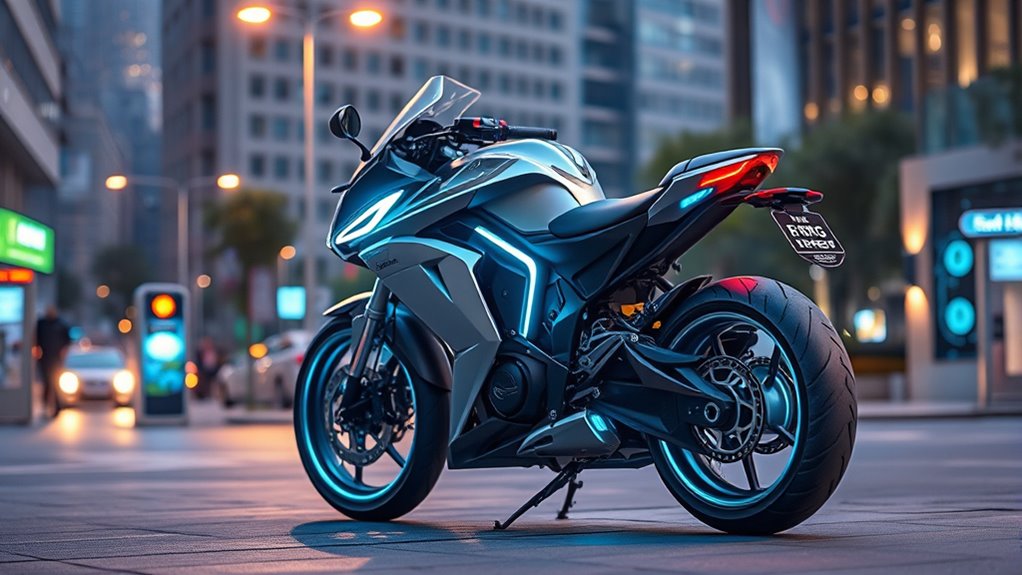
Emerging battery technologies like solid-state cells and graphene-enhanced lithium-ion batteries are set to dramatically boost your motorbike’s range and durability. Rapid charging innovations now cut recharge times to about 12 minutes for most high-performance bikes, while wireless charging prototypes offer quick top-ups during short stops. Removable batteries also give you greater flexibility, letting you swap and recharge easily, reducing downtime and range anxiety. Additionally, user-friendly apps and tracking tools are increasingly being integrated to monitor battery health and optimize charging routines. These advanced management systems will be crucial for maintaining battery efficiency and safety as technology evolves. Moreover, battery safety protocols are becoming more sophisticated to prevent overheating and prolong lifespan, which is vital for rider confidence. As the industry advances, battery management systems will play a crucial role in ensuring the longevity and safety of electric motorbikes. Incorporating proper storage techniques ensures batteries maintain optimal performance over time, especially during periods of inactivity.
Solid-State Battery Breakthroughs
Solid-state batteries are rapidly transforming the future of electric motorbikes by offering higher energy densities and faster charging times than traditional lithium-ion models. With an energy density of around 500 Wh/kg, they enable you to ride over 300 miles per charge, vastly improving range. These batteries also support rapid charging, with prototypes reaching 80% capacity in just 12 minutes—much quicker than conventional options. Their enhanced thermal stability reduces overheating risks, ensuring safer high-performance riding. Researchers are developing solid electrolytes that extend battery longevity, pushing lifespan to about 2,000 charge cycles—nearly double that of current lithium-ion batteries. Industry investment from companies like CATL and Toyota signals a promising future for solid-state battery technology, paving the way for more durable, efficient, and safe electric motorbikes in the coming years. Additionally, advancements in thermal stability are crucial for maintaining safety during high-power usage. Moreover, ongoing research into battery safety aims to mitigate potential risks associated with high-energy storage. Furthermore, innovations in manufacturing processes are expected to reduce production costs, making solid-state batteries more accessible to consumers. As the development of energy management systems continues, these batteries will become even more reliable and integrated into next-generation electric vehicles. Recent breakthroughs in material science are also contributing to improved electrode stability and overall battery performance.
Rapid Charging Innovations
Advancements in battery technology are driving faster and more convenient charging options for electric motorbikes. Industry-standard fast-charging solutions now deliver fast recharge times, allowing you to reach 80% capacity in about 40-45 minutes, with some models achieving full charge in roughly an hour. Emerging battery tech, like solid-state batteries with energy densities of 500 Wh/kg, enable rapid charging within 12 minutes and extend range considerably. Battery swapping stations, supported by companies like Willow, offer quick exchanges, reducing downtime. Wireless charging prototypes, such as BMW’s CE 04, provide 15% top-ups during short stops, enhancing convenience. As charging infrastructure expands, these innovations promise to make electric motorcycles more practical, with improved fast-charging solutions that fit seamlessly into your riding routine. Additionally, the development of cost-effective charging solutions is crucial for widespread adoption and convenience. The integration of smart charging networks further optimizes energy use and reduces wait times for riders. Incorporating natural materials and vintage-inspired accessories can also enhance the aesthetic appeal of charging stations, creating a more inviting environment for users. Moreover, ongoing research into sustainable energy sources is expected to support greener and more efficient charging options in the future, with innovations in renewable energy playing a pivotal role.
Wireless Power Delivery
Building on recent innovations, wireless power delivery is transforming how electric motorbikes recharge, allowing you to top up your battery without plugging in. Imagine seamless, convenient recharging with wireless charging and resonant inductive charging stations that support rapid recharging—some systems hit 80% in under 15 minutes. Industry efforts focus on developing standardized protocols and widespread charging infrastructure, making electric motorbikes more practical daily. With battery-free power transfer utilizing ambient electromagnetic fields, future models could eliminate onboard batteries altogether. This evolution promises a future where you enjoy effortless, reliable power without the hassle of traditional plug-in methods. Additionally, AI security solutions are being integrated into charging infrastructure to monitor and prevent cyber threats, enhancing safety and reliability. Embrace the shift toward battery-free power transfer and experience a new era of mobility.
Impact of Government Policies and Incentives
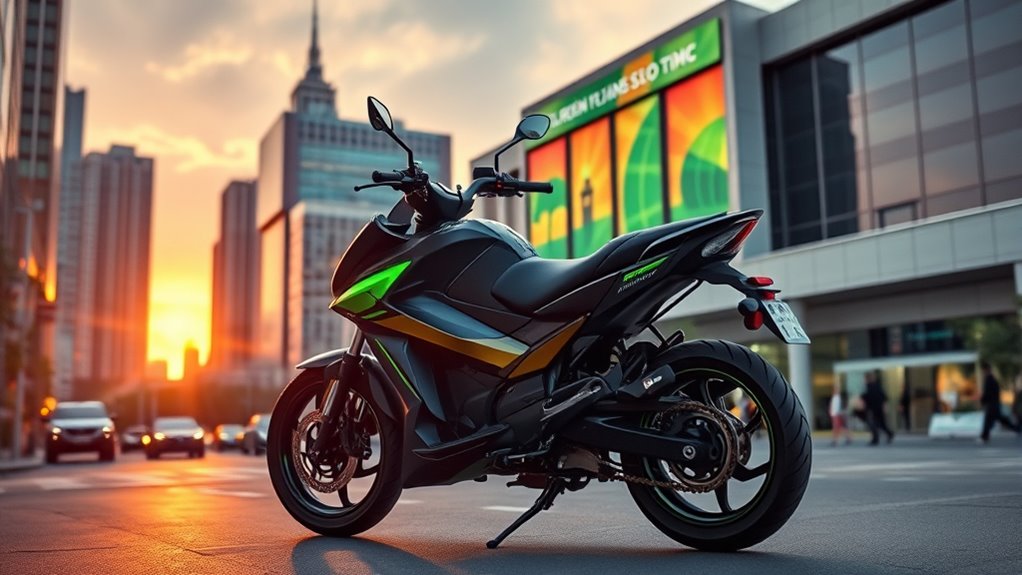
Government policies and incentives are transforming the electric motorcycle market by making these vehicles more affordable and accessible. Subsidies, tax rebates, and urban restrictions are encouraging consumers and manufacturers to prioritize electric models. As a result, policy-driven market shifts are accelerating adoption worldwide.
Policy-Driven Market Shifts
Policies and incentives are driving significant shifts in the electric motorcycle market by making these vehicles more accessible and attractive to consumers. Governments worldwide are offering policy incentives—such as tax rebates and toll exemptions—that accelerate EV adoption and boost market penetration. These measures foster a favorable regulatory environment, encouraging manufacturers to develop more electric models. Key developments include:
- Substantial tax rebates in over 15 countries, increasing consumer confidence.
- Urban policies like zero-emission mandates, creating demand.
- Infrastructure investments, like India’s $1.3 billion scheme, easing charging challenges.
- Environmental policies pushing for cleaner transportation, fostering market shifts.
Together, these efforts amplify government support, transforming the electric motorcycle market into a dynamic, rapidly growing industry.
Incentives Accelerate Adoption
Incentives and government-backed policies are rapidly boosting electric motorcycle adoption worldwide. These electric motorcycle incentives, including subsidies, tax rebates, and toll exemptions, markedly reduce purchase costs and encourage consumer demand. Countries like France, Norway, and regions such as the EU and India are leading with policies that promote market adoption through infrastructure support and electric vehicle incentives. The U.S. offers rebates of up to $1,500 for low-income buyers, removing financial barriers. As a result, market growth accelerates, with projections of over 60 million units sold globally in the next decade. Here’s a snapshot of key incentives driving adoption:
| Country/Region | Incentives & Policies | Impact on Market |
|---|---|---|
| Norway, France | Subsidies, toll exemptions | Increased adoption |
| EU, India | Infrastructure support, bans | Market expansion |
| USA | Rebate programs | Lower costs for buyers |
| Thailand, Singapore | Toll discounts, free charging | Consumer demand boom |
| Global | Incentive-driven growth | Adoption acceleration |
Innovations in Connectivity and Smart Features
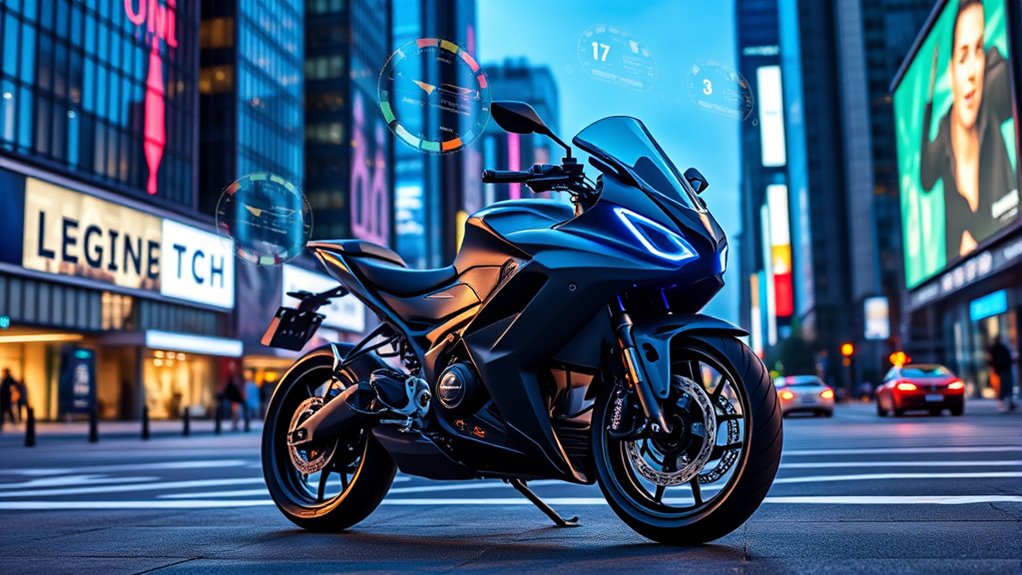
As electric motorbikes become more prevalent, their integration with advanced connectivity and smart features is transforming your riding experience. You’ll benefit from smart connectivity that leverages IoT technology for real-time monitoring and software updates. Imagine GPS navigation guiding you effortlessly, vehicle-to-vehicle communication enhancing safety, and smartphone app integration controlling locks, ride data, and maintenance alerts. These innovations enable predictive maintenance by analyzing sensor data, predicting failures before they happen. With the rollout of 5G networks, data exchange becomes faster, allowing seamless real-time updates and interactions.
Here’s what you can look forward to:
- Enhanced safety features like collision warnings and blind-spot detection
- Smarter maintenance with predictive insights
- Effortless connectivity through 5G
- Improved ride safety and convenience
Market Expansion and Consumer Adoption Trends
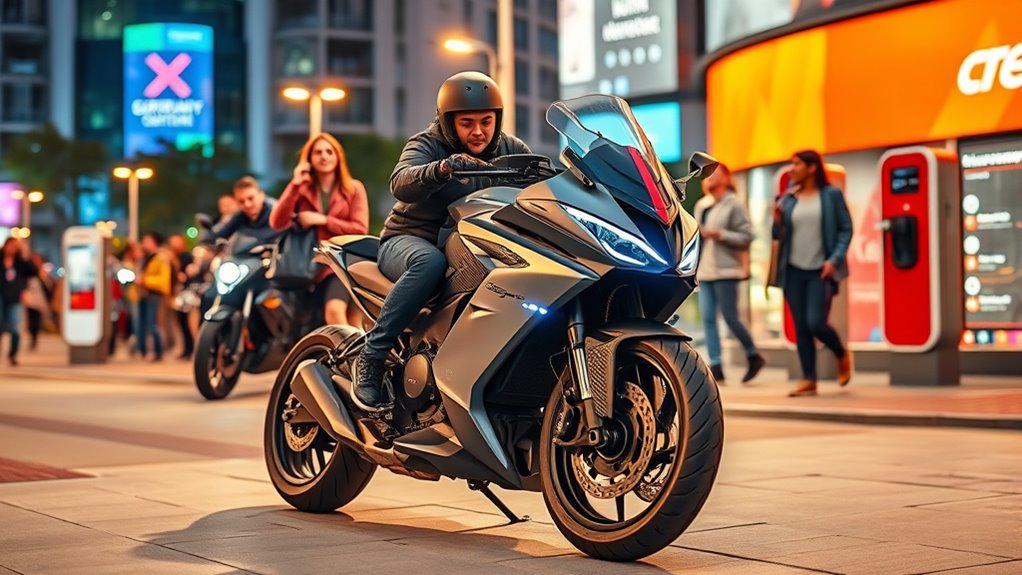
The electric motorcycle market is experiencing rapid growth, fueled by technological advances and increasing consumer interest. Market expansion is driven by improvements in battery technology and the development of fast-charging infrastructure, which ease range anxiety and encourage more consumer adoption. In urban areas, government incentives like tax rebates, reduced tolls, and free charging lower ownership costs, making electric bikes more attractive. Countries like Norway and China already see electric motorbikes capturing over 50% market share, showing strong acceptance among environmentally conscious and budget-savvy buyers. Younger, tech-savvy riders favor high-end, smart-connected models, boosting overall market share. As these trends continue, the electric motorcycle market is poised for significant expansion, with more consumers embracing sustainable, efficient, and innovative transportation options.
Sustainability Challenges and Environmental Considerations
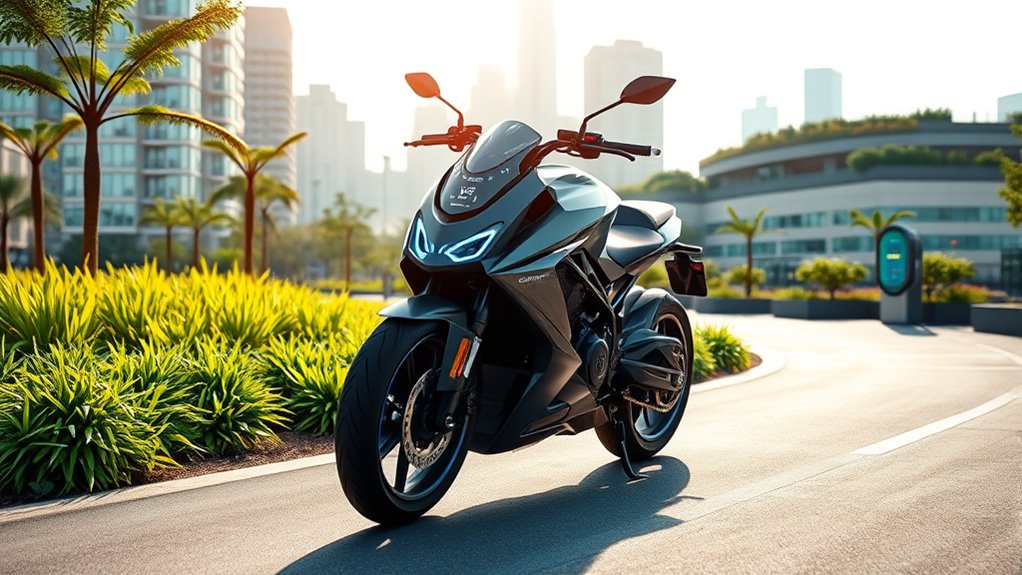
While the growth of electric motorbikes has gained momentum thanks to advances in technology and supportive policies, sustainability challenges remain at the forefront. Battery manufacturing involves raw material sourcing that considerably impacts the environment, raising concerns over ecological footprints. To address this, manufacturers are exploring recycled materials and eco-friendly production methods to improve lifecycle sustainability. However, recycling and disposal of batteries pose environmental risks if not managed properly, emphasizing the need for advanced recycling technologies. Additionally, the overall environmental benefit depends heavily on sourcing renewable energy for charging, which reduces carbon emissions.
Your awareness of these issues can inspire change:
- Demand eco-friendly production practices
- Support recycling innovations
- Advocate for responsible raw material sourcing
- Choose bikes powered by renewable energy
Frequently Asked Questions
What Is the Future for Motorbikes?
You can expect motorbikes to become more eco-friendly, smart, and high-tech. Electric models will dominate the market, offering longer ranges, faster charging, and better convenience through innovations like wireless charging and IoT features. As governments push for cleaner transportation and infrastructure improves, you’ll see more stylish, high-performance bikes that are easier to use and maintain, making riding more enjoyable and sustainable for you.
What Is the Growth of Electric Motorcycle?
You see that electric motorcycle market is booming, with sales expected to hit around 60 million units annually in the next decade. Currently, in 2023, China alone sold about 4.81 million units. The market’s growth rate exceeds 10% annually, driven by technological innovations and expanding charging networks. Emerging markets like India and Southeast Asia are rapidly adopting electric bikes, making this a promising and dynamic industry to watch.
What Is the Lifespan of an Electric Motorcycle?
Think of your electric motorcycle’s lifespan like a well-loved book—lasting years with proper care. Typically, the battery lasts 8 to 12 years, or about 1,500 to 2,000 charge cycles. Advances like solid-state tech could extend this. Regular maintenance and good thermal management help, and warranties cover around 8 years. When the battery reaches the end, it can be recycled or repurposed, keeping your bike sustainable long-term.
Is There a Market for Electric Motorcycles?
You’ll find there’s definitely a market for electric motorcycles. The global demand is growing rapidly, with millions sold annually and policies supporting adoption. Advances in battery tech and new models from startups and big brands make electric bikes more attractive and practical. Incentives like rebates and urban policies encourage you to choose electric, and as the market expands, you’ll see more options tailored to your riding needs.
Conclusion
As you ride into the future of electric motorbikes, remember they’re like a rising tide lifting all boats—advancements, policies, and consumer enthusiasm propel the industry forward. With innovations accelerating, you’ll soon experience longer rides, smarter features, and greener journeys. Just as a small spark ignites a blazing fire, today’s breakthroughs will shape a sustainable, exciting riding experience for you and generations to come. Embrace the change—your journey is just beginning.
